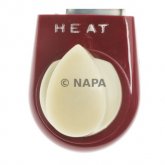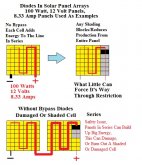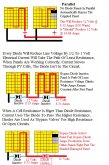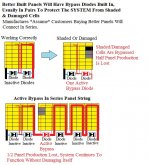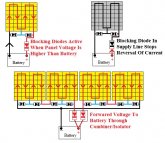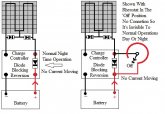Just a bypass from battery power (positive battery connection), through the rheostat, switch or resistor, and to the panel positive terminal of the charge controller.
If you have external blocking diodes (Isolated/Combiner Boxes) to the panel side of those diodes.
You simply jump batteries to panels, the panels NOT producing are the load, and current flows 'Backwards' to battery negative, heating the panels in the process.
And AGAIN, I'm NOT trying to sell this as a 'Home Game', if you don't understand the Volts/Amps your panels are capable of handling, or if you don't understand the function of Blocking Diodes, DO NOT attempt this.
Batteries contain Several Hours of full sunlight production power, and CAN over power the panels, cause damage.
==============
Diodes used for blocking first, and they are found in your charge controller,
OR, if you have ISOLATION blocks in your panel strings.
*MOST* small systems DO NOT have isolators in the panel strings.
Diodes used for 'Bypass' in panels ARE NOT blocking Diodes,
They are to bypass current flow around shaded or damaged CELLS/Cell Strings.
Anyone that tells you the diodes IN PANELS are Blocking Diodes doesn't understand what they are for or how they are connected.
View attachment 4474
When production is backed up, Voc shoots to the moon, and resistance heating in the damaged or shaded cells can be overcome by backup.
Bypass diodes simply give a path for that energy to BYPASS the effected areas.
View attachment 4475
How Bypass Diodes installed in modern panels are actually wired, and what they actually look like.
View attachment 4476
With Solar Cells Strings 'Center Tapped', there is a reason the Bypass Diodes are mounted in the center of the panel...
View attachment 4477
Since these diodes are INACTIVE when there isn't something wrong with the cells/cell strings,
AND since there is direct connection around the diodes when current flows the other direction (Backwards of Intended Travel Path)
Bypass diodes are invisible to REVERSION in electrical current from the battery.
==================================================
DIODES USED FOR BLOCKING...
Same component (Diode) but used in a different position for different application,
And the small system charge controllers, there is a set built into the charge controllers first thing when Positive Voc hits the panel input terminal...
If you have larger strings that are combined, depending on how those panels are wired, they MAY have blocking diodes external the charge controller.
If you didn't add them they aren't there...
View attachment 4473
Since the panels are quite capable of sucking your battery dry at night, one of the things a charge controller does is stop the panels from sucking your battery dry,
In this SIMPLE example, there is no charge controller so I can show how this happens, and how to stop it.
While some people call this 'Reverse Polarity', nothing 'Reverses Polarity',
In full production (Sunny) the panel has higher than battery voltage, the voltage flows the lesser (Called Voltage Differential).
Without the panel producing, it's no longer a 'Source', so now it becomes a 'Load'.
With higher than battery voltage, the Positive finds a Negative Path, and that's through the conductive traces in the panel.
With a Diode in the right position, it simply stops, or BLOCKS the reversion, but allows panel to feed battery in sunlight.
A Diode is an electrical 'One Way Valve'.
View attachment 4478
------------------------------------------------------------
With No Isolation Diodes in the system, I simply Jump the charge controller terminals with a Rheostat.
View attachment 4482
The Rheostat allows me to pass only the current from batteries needed to melt a layer of ice next to the panel.
I crank up a little each time they are iced over so they melt off in about 10-15 minutes and mark the Rheostat.
*IF* production starts happening, the Rheostat limits the panel production to batteries so batteries don't get full voltage potential.
The charge controller is often less resistance than the Rheostat, so most of the current will take that path.
You MUST remember to turn the Rheostat OFF! And never use it in full sunlight production.
A safety switch in the circuit would make using it a 2 (easy) step process,
And a mechanical timer would automatically limit the time it was bypassing the charge controller.
View attachment 4483
,
